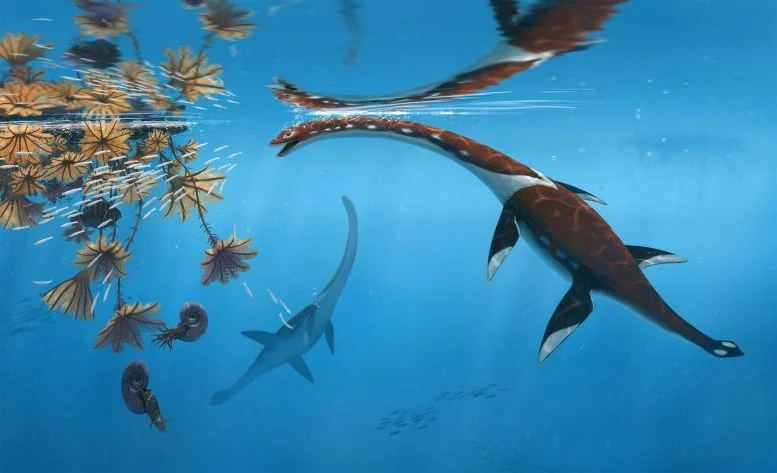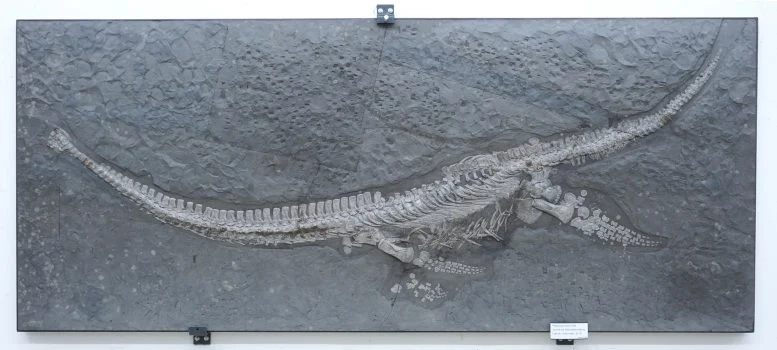 Plesionectes longicollum life reconstruction. Credit: Peter Nickolaus
Plesionectes longicollum life reconstruction. Credit: Peter Nickolaus
A fossil dug up in Germany in 1978 has finally revealed its secret: it belongs to a previously unknown Jurassic sea reptile.
The long-necked creature lived 183 million years ago, and its skeleton even includes traces of soft tissue. Scientists only recently recognized it as a new species after a detailed reexamination.
Unearthing a Jurassic Ocean Predator
Paleontologists have discovered a previously unknown species of ancient marine reptile in Germanys famous Posidonia Shale, providing new insight into ocean life nearly 183 million years ago.
The species, officially named Plesionectes longicollum (which means long-necked near-swimmer), is a new member of the plesiosauroid family. These long-necked reptiles once roamed the seas during the time of the dinosaurs. The fossil is almost completely intact and even includes rare traces of preserved soft tissue. Although it was originally unearthed in 1978 from a quarry in Holzmaden, a town in southwestern Germany, its distinct physical traits have only recently been fully recognized through thorough scientific study.
 Plesionectes skeleton at the Staatliches Museum f�r Naturkunde Stuttgart. Credit: State Museum of Natural History Stuttgart
Plesionectes skeleton at the Staatliches Museum f�r Naturkunde Stuttgart. Credit: State Museum of Natural History Stuttgart
A Fossil Hiding in Plain Sight
This specimen has been in collections for decades, but previous studies never fully explored its distinctive anatomy, said Sven Sachs of the Naturkunde-Museum Bielefeld, the studys lead author. Our detailed examination revealed an unusual combination of skeletal features that clearly distinguish it from all previously known plesiosaurs.
Sachs and co-author Dr. Daniel Madzia of the Polish Academy of Sciences published their findings to highlight that the Posidonia Shale, already renowned for its remarkably well-preserved fossils, may hold even more marine reptile diversity than scientists previously thought.
The Oldest Plesiosaur in Holzmaden
The Plesionectes specimen is particularly significant as it represents the oldest known plesiosaur from the Holzmaden area. Despite being an immature individual, its distinctive anatomical characteristics were not significantly affected by its developmental stage, warranting classification as an entirely new genus and species.
This discovery adds another piece to the puzzle of marine ecosystem evolution during a critical time in Earths history, explained Dr. Madzia. The early Toarcian period, when this animal lived, was marked by significant environmental changes, including a major oceanic anoxic event that affected marine life worldwide.
A New Star in Stuttgarts Collection
The fossil is permanently housed at the Staatliches Museum f�r Naturkunde Stuttgart (Stuttgart State Museum of Natural History) where it is cataloged as specimen SMNS 51945.
The Posidonia Shale at Holzmaden has previously yielded five other plesiosaur species, including representatives from all three major plesiosaur lineages. This new addition further cements the formations status as one of the worlds most important windows into Jurassic marine life.
Reference: An unusual early-diverging plesiosauroid from the Lower Jurassic Posidonia Shale of Holzmaden, Germany by Sven Sachs and Daniel Madzia, 4 August 2025, PeerJ.
DOI: 10.7717/peerj.19665
Never miss a breakthrough: Join the SciTechDaily newsletter.




